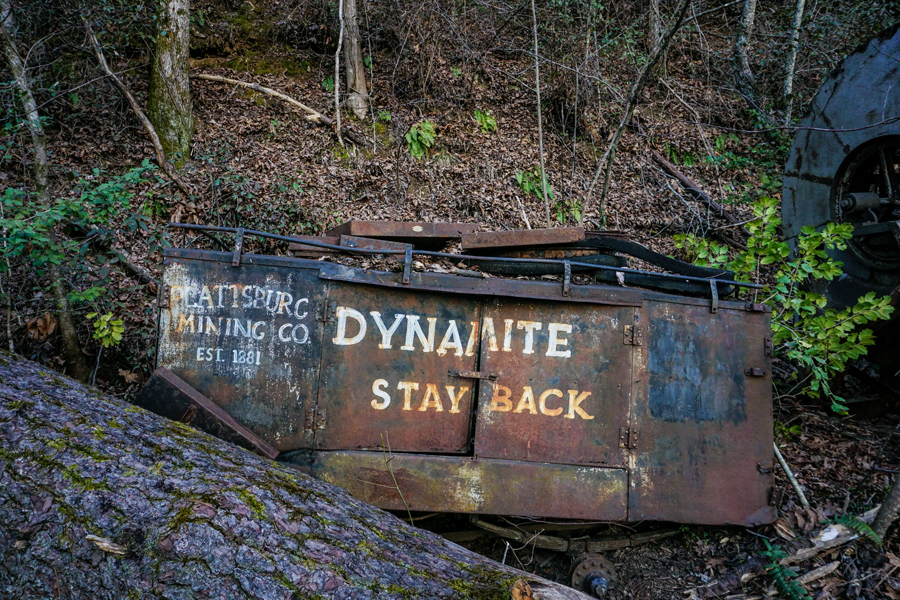Nestled in the embrace of the North Georgia mountains, a mere scenic hour-and-a-half drive from Atlanta, lies the enchanting town of Helen. With its cobblestone alleys, whimsical gingerbread-trimmed buildings, and an atmosphere brimming with Bavarian cheer, Helen is a beloved escape, a picture-perfect Alpine village transported to the American South. Yet, beneath this charming, relatively modern veneer—a delightful transformation conceived in the late 1960s —lies a much older, wilder tale, one of grit, ambition, and the glimmer of gold that sparked America’s first major gold rush. Long before the festive notes of Oktoberfest echoed through the valley, the Nacoochee Valley, where Helen sits, was a frontier abuzz with the cries of “Gold!” This area marked the eastern edge of the Great Georgia Gold Rush belt, a region whose historical significance rivals, and indeed predates, the famed California Gold Rush. This journey unearths Helen’s golden past, traces the glittering veins to the nearby historic town of Dahlonega, and guides modern-day adventurers to where they, too, can seek their fortune.
Helen’s Heyday: Echoes of Gold in the Nacoochee Valley
The story of Helen’s transformation into an Alpine village is a testament to its community’s ingenuity, a response to the decline of earlier industries like logging. However, to truly understand the layers of Helen’s identity, one must travel back further, to a time when the earth itself promised riches. This earlier chapter, etched by the pursuit of gold, fundamentally shaped the region and left an indelible mark on the landscape and its people.
The Spark: Gold on Dukes Creek (1828)
The quiet Nacoochee Valley was irrevocably altered in 1828 with the discovery of gold along Dukes Creek. This pivotal event ignited the Georgia Gold Rush, drawing prospectors and fortune-seekers to the foothills of North Georgia. The Nacoochee-Helen Valley quickly became recognized as the eastern frontier of this sprawling gold belt, which stretched westwards to Dahlonega. The allure of gold was potent; thousands of miners descended upon the valley, tirelessly working the land. For over a century, these individuals mined the streams and hillsides, extracting thousands of pounds of the precious metal. This prolonged period of mining activity indicates an economic engine that, while perhaps fluctuating, provided a sustained foundation for the area’s early development, far exceeding the typical image of a short-lived boom.
However, this era of golden opportunity was not without its profound and somber consequences. Prior to 1800, the lands around Helen and the Nacoochee Valley were the heart of the Cherokee Indian culture, dotted with their villages and ceremonial sites. The influx of miners and the subsequent land grab by settlers, fueled by the gold discovery, intensified the pressure on the Cherokee Nation. This “Great Intrusion,” as the Cherokee termed it , was a direct precursor to the tragic forced removal of the Cherokee people from their ancestral lands along the Trail of Tears in the 1830s. The pursuit of gold, therefore, is inextricably linked to this dark chapter in American history, a vital context to remember when exploring the region’s glittering past.
Historic Mines of Helen: Remembering England Gold Mine and Hamby Mountain
Within the Nacoochee-Helen Valley, several sites became focal points of intense mining activity. Among the most notable were the historic England Gold Mine and Hamby Mountain, both of which were extensively worked during the gold rush era. These locations, and others like them, contributed significantly to the thousands of pounds of gold wrested from the Georgia soil.
The historical records indicate that the most fervent mining operations in this area began to wane by the close of the 19th century. As the easily accessible gold diminished and other economic opportunities arose elsewhere, many settlers moved on, and the landscape began a slow process of change. Interestingly, the England Gold Mine is often referred to as the “site of Helen’s current gold mine”. While specific details of a direct successor on the exact same grounds are sparse in these historical accounts, this reference hints at the enduring legacy of gold in the area. It suggests a continuity, perhaps through the tourist-focused gold panning operations that exist today, some of which source their “paydirt” from historically significant locations like Dukes Creek , thereby connecting modern recreation directly to these historic mining grounds.
A Walk Through History: Smithgall Woods, Duke’s Creek, and Martin’s Mine Trail
For visitors wishing to connect directly with Helen’s gold mining past, Smithgall Woods State Park offers a unique opportunity. Located just a five-minute drive from Helen, this park is a sanctuary of natural beauty with a deep history. Duke’s Creek, the very stream where gold was first reported in Georgia in the early 1800s, flows through the property, making Smithgall Woods a site of primary historical significance.
The legacy of the gold rush here is twofold. For a century following the initial discovery, the land that would become Smithgall Woods was subjected to intensive mining. The relentless search for gold led to significant environmental degradation; the area was described as “destroyed and pillaged”. This stark reality offers a more complete picture of the gold rush era, acknowledging that the pursuit of riches often came at a considerable ecological cost. However, the story of Smithgall Woods is also one of redemption. In the 1940s, Charles Smithgall, a noted conservationist, began acquiring the ravaged land. Over decades, he invested significantly in its restoration, eventually gift-selling the vast majority of the property to the State of Georgia in 1994 to ensure its continued preservation.
Today, visitors to Smithgall Woods can hike the Martin’s Mine Trail, which leads to an old gold mine. This trail offers a tangible link to the past, allowing hikers to tread paths once walked by hopeful miners. It’s a quiet reminder of the labor and dreams that characterized the gold rush, set against a backdrop of a landscape slowly healed by dedicated conservation efforts.
Dahlonega: The Heartbeat of America’s First Gold Rush
While Helen and the Nacoochee Valley were significant players on the eastern front of the Georgia Gold Rush, the undisputed heart of this historic event beat strongest in Dahlonega, a town whose very name is derived from the Cherokee word for “yellow” or “gold.” Dahlonega’s story is central to understanding the magnitude and impact of America’s first major gold rush.
“There’s Gold in Them Thar Hills!”: The Dahlonega Story
Dahlonega sits atop some of the largest gold deposits ever found east of the Mississippi River. The official start of the Dahlonega gold rush is often credited to Benjamin Parks, a deer hunter who reportedly tripped over a gold-laden rock in 1828, just a short distance south of what is now Dahlonega. News of such discoveries spread like wildfire. Within a single year, an estimated 15,000 miners had flooded into the Dahlonega area, transforming the quiet territory into a bustling hub of prospecting. As Benjamin Parks himself recounted, “The news got abroad, and such excitement you never saw…men came from every state I had ever heard of…acting more like crazy men than anything else”.
It is this feverish atmosphere that likely gave rise to the iconic American phrase, “There’s gold in them thar hills!” While its exact origins are debated, the saying is strongly associated with the Georgia Gold Rush and Dahlonega. Many accounts link it to Dr. Matthew Fleming Stephenson, an assayer at the Dahlonega Mint. As miners began to leave Georgia for the newer goldfields of California, Stephenson is said to have stood on the courthouse steps, pointed to the local mountains, and passionately urged them to stay, proclaiming the continued richness of Georgia’s gold. The phrase was later popularized by Mark Twain in his 1892 novel, The American Claimant, where the character Colonel Mulberry Sellers, thought to be based on Stephenson, utters a similar sentiment. This enduring expression captures the spirit of boundless optimism and discovery that defined the era.
From Discovery to a U.S. Mint: Coining a Fortune
The sheer quantity of gold being extracted around Dahlonega quickly drew national attention. Recognizing the economic importance of the region and the need for a regulated way to process the gold, the United States Congress authorized the establishment of a U.S. Branch Mint in Dahlonega. The mint commenced operations in 1838, producing gold coins exclusively. Before its closure in 1861 at the onset of the Civil War, the Dahlonega Mint produced over $6 million worth of gold coins, which are now highly prized by collectors.
The establishment of a federal mint was a profound validation of the Georgia Gold Rush. It signified that this was not merely a local scramble for riches but an event of national economic consequence, a “national affirmation” and a “seal of approval” for the region’s burgeoning industry. After the mint ceased operations and the original building later burned down in 1878, its foundation became the site for Price Memorial Hall of North Georgia Agricultural College, now the University of North Georgia. The iconic gold-covered steeple of Price Memorial Hall today stands as a gleaming reminder of the land’s golden legacy.
The Enduring Legacy: Dahlonega’s Golden Mark on Georgia
By the early 1840s, the easily accessible surface gold in the Dahlonega region began to diminish. When news of the massive gold strikes in California reached Georgia in 1849, many of Georgia’s experienced miners, the “twenty-niners,” headed west to seek new fortunes, becoming some of California’s first “forty-niners”. This exodus represented a significant transfer of mining knowledge and manpower, effectively making the Georgia goldfields a proving ground for the larger rushes that would shape the American West.
Despite this westward migration, Dahlonega’s golden identity remained. A testament to this enduring legacy is the gleaming dome of the Georgia State Capitol in Atlanta. In 1958, citizens of Dahlonega and Lumpkin County, in a display of regional pride, donated 43 ounces of locally mined gold to gild the capitol dome. This symbolic gesture has been repeated, with subsequent regilding efforts ensuring that Dahlonega gold continues to adorn this prominent state symbol. Notably, a portion of this gold came from the Crisson Gold Mine , a site still welcoming visitors today, creating a direct, tangible link between a historic, operational mine and a major emblem of Georgia’s heritage.
Strike it Rich! Your Guide to Gold Panning & Gem Mining Adventures Today
The “gold fever” that gripped North Georgia nearly two centuries ago still echoes in the hills and streams, albeit in a more recreational form. Today, visitors to Helen and Dahlonega have numerous opportunities to connect with this rich history through hands-on gold panning and gem mining experiences. These attractions offer more than just a history lesson; they provide immersive activities that make the past come alive, appealing to families, history buffs, and aspiring prospectors alike. The success of these heritage tourism sites demonstrates a clever adaptation, transforming historical narratives into sustainable economic contributors for the local communities, much like Helen’s own Alpine reinvention.
Below is a guide to some of the premier locations where one can try their luck and learn about the region’s glittering past:
Gold & Gem Mining Hotspots Near Helen & Dahlonega
| Name | Type | Offerings Summary | Address | Phone | Website | Approx. Distance from Helen |
|---|---|---|---|---|---|---|
| Outpost Gold & Gem Panning | Gold Panning, Gem Mining | Uses “Georgia Gold Rush Paydirt” from historic Dukes Creek. Offers various bucket sizes for gold and gemstones (rubies, sapphires, emeralds). Features covered panning tables, staff assistance, and a gift shop. | 7901 S Main St, Helen, GA 30545 | (706) 878-5065 | outpostgoldandgems.myshopify.com | In Helen |
| Dukes Creek Gold and Ruby Mines | Gem Mining, Gold Panning (implied) | Specializes in panning for a variety of gemstones including rubies, sapphires, and emeralds. Provides comfortable, shaded panning tables. Staff available for evaluation of finds for cutting/setting. On-site Dukes Creek General Store offers local products. | 6145 GA-75, Sautee Nacoochee, GA 30571 | (706) 878-2625 | helenga.org/dukes-creek-mines/ | ~4-5 miles |
| Consolidated Gold Mine | Underground Mine Tours, Gold Panning, Gem Mining | Features Dahlonega’s only underground gold mine tour, descending over 200 feet. Offers gold panning instruction and gem mining with guaranteed gemstones. On-site lapidary studio. Historically the largest gold mining operation east of the Mississippi River. Gold from this mine adorns the GA State Capitol Dome. | 185 Consolidated Gold Mine Road, Dahlonega, GA 30533 | (706) 864-8473 | www.consolidatedgoldmine.com | ~25 miles |
| Crisson Gold Mine | Gold Panning, Gem Mining, Historical Museum | Georgia’s oldest gold panning establishment (since 1969). Still an active mine (last commercial operation in 1982). Offers gold panning, gem mining, and self-guided tours of historic equipment, including a working 140-year-old Stamp Mill. Features a rock shop and sells mining equipment. Dahlonega gold is noted for its 98.7% purity (over 23KT). | 2736 Morrison Moore Pkwy E, Dahlonega, GA 30533 | (706) 864-6363 | www.crissongoldmine.com | ~25 miles |
| Dahlonega Gold Museum Historic Site | Museum | Housed in the historic 1836 Lumpkin County Courthouse. Exhibits detail America’s first major gold rush, featuring a complete set of rare Dahlonega-minted gold coins, a 5-ounce gold nugget, a hydraulic cannon, a 17-minute film, and the story behind “There’s gold in them thar hills!”. | 1 Public Square, Dahlonega, GA 30533 | (706) 864-2257 | (https://gastateparks.org/DahlonegaGoldMuseum) | ~25 miles |
Plan Your Golden Getaway to Helen, GA
While the Alpine village atmosphere of Helen is undoubtedly a primary attraction, drawing visitors year-round for its unique shops, restaurants, and festive events like Oktoberfest , the region’s rich gold rush history offers a compelling additional dimension to any visit. Helen’s strategic location in the North Georgia mountains makes it an excellent base not only for exploring its own historical connections to gold but also for venturing to the nearby historic town of Dahlonega and the natural beauty of sites like Smithgall Woods State Park.
A trip to Helen can easily incorporate day excursions to these mining-related attractions, with Dahlonega being a comfortable drive of approximately 45 minutes. This allows visitors to immerse themselves in the gold rush narrative, perhaps trying their hand at panning in the morning and enjoying Helen’s river tubing or hiking trails in the afternoon. Such a combined itinerary offers a well-rounded experience, blending history, adventure, and the unique cultural charm that defines this corner of Georgia. By serving as a hub for regional exploration, Helen broadens its appeal, inviting visitors to discover a landscape rich in both natural beauty and historical depth.
Discover Georgia’s Golden Treasures
The story of gold in North Georgia is a captivating narrative of discovery, ambition, environmental impact, and enduring legacy. From the initial strikes on Dukes Creek near Helen to the bustling mint in Dahlonega, this region was the stage for America’s first major gold rush, a period that profoundly shaped its communities and even played a role in the nation’s westward expansion.
Today, the echoes of that golden era resonate through the preserved landscapes, the carefully curated museum exhibits, and the exciting, hands-on experiences offered at local panning and mining attractions. Visitors have the unique opportunity to step back in time, to learn about the challenges and triumphs of the early miners, and to feel the timeless thrill of searching for gold and gems. Whether one is drawn by the historical significance, the allure of potential treasure, or simply the desire for a unique family adventure, Helen and its surrounding golden heritage sites offer a journey of discovery. Unearth the stories, explore the historic trails, and perhaps, with a little luck and a swirl of the pan, uncover a glittering treasure of one’s own in the beautiful hills of North Georgia.om!




